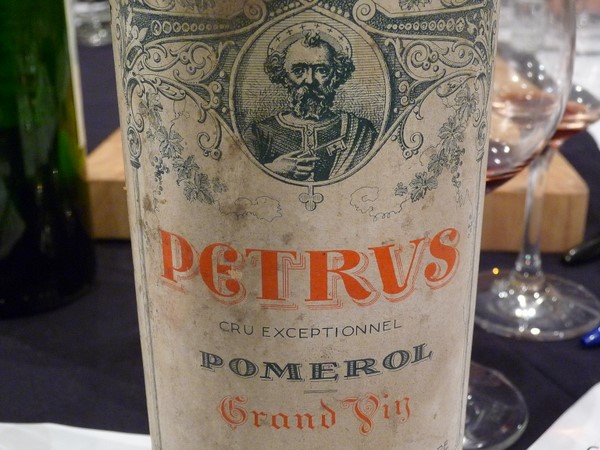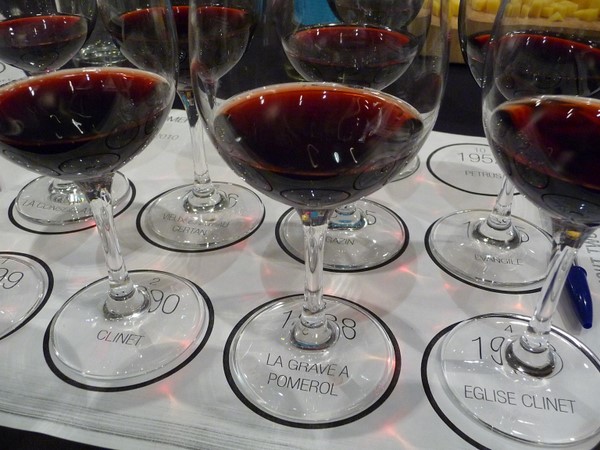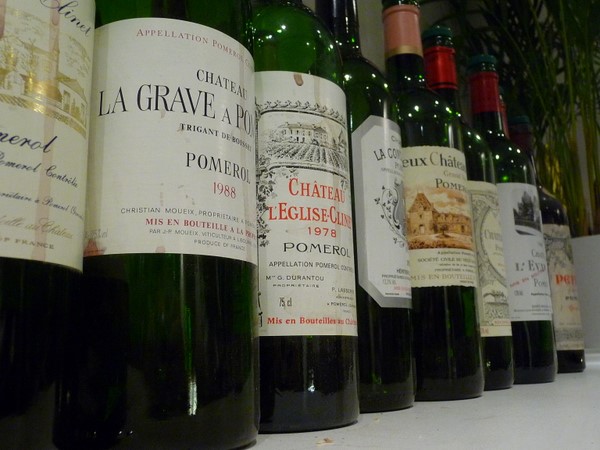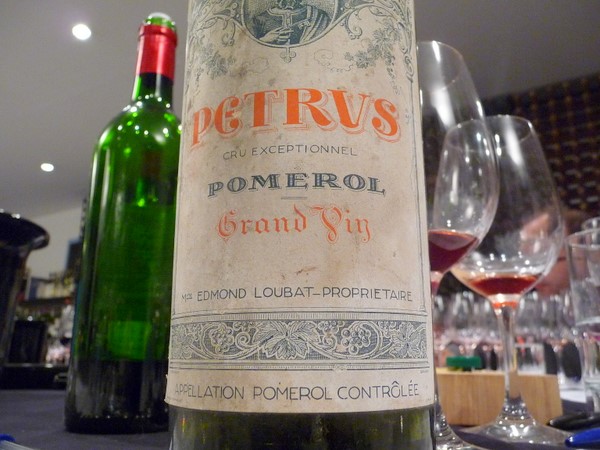|
The
wines of Pomerol: 'Bordeaux's afterthought'
Notes on a grand tasting at Roberson, presented by Neal Martin
Roberson
Fine Wine, November 2010

‘Pomerol
is the afterthought in Bordeaux,’ says Neal Martin, who was
compering this tasting. ‘It hasn’t had much written about it
before, which is why I decided to write a book on it.’
Neal’s magnum opus isn’t published yet: he’s still finishing it off.
But it sounds like it will be a huge door wedge of a book, full of
anecdote and history.

The
appellation, on Bordeaux’s right bank, has just 780 hectares of
vines, which is tiny: the same size as St Julien. To the north is
the Barbanne river; to the east/southeast St Emilion; and to the
west Libourne. The town of Libourne has actually used up a lot of
the really good terroir of Pomerol.
The
history of Pomerol is vague. Unlike that of the well documented left
bank, Pomerol’s history is full of gaps. There is evidence of
Roman settlement, yet no trace of Roman vines. Viticulture here
started in the 11th/12th centuries.

Through
history, Pomerol has consisted largely of small properties, usually
practising polyculture, which were then made even smaller by
inheritance. It stayed this way until the 19th century, when bigger
estates emerged through the practice of sharecropping. These
included the likes of Sertan (now Vieux Chateau Certan) and Gazin.
It
was only towards the beginning of the 20th century that crops such
as cereals and maize were phased out. In this respect, Pomerol was
effectively 150 years behind the left bank.

Indeed,
Pomerol wasn’t really taken seriously as a region until the 1950s,
when the owner of Petrus, Mme Loubat, started charging more for her
wines. The Moueix family, who were negociants, acquired the rights
to sell Petrus, and had the business acumen to establish a
reputation for the region. Jean-Pierre Moueix was a brilliant
businessman, and Neal comments that the Mouiex family could now have
even more properties in the region if it weren’t for the bad
decisions made by some of the other family members. For example,
Vieux Chateau Certan should be a Mouiex property: Anton Moueix had
the option to buy either this or another property in the 1920s, but
chose the less prestigious other property simply because it was
nearer the station.
Neal
also points out that to this day there are many tiny properties in
the region, as small as 0.1 hectares. Altogether there are 160–170
producers in the region, and he speculates that there could be good
wines waiting to be discovered.
‘The
deceiving thing about Pomerol,’ says Neal, ‘is that most wines
reach their maturity earlier than those from the left bank, and you
think you have to drink them up. But they then go on to evolve into
something else, giving you something that rewards cellaring.’
Pomerol
is dominated by Merlot, which is supplemented by Cabernet Franc and
sometimes a dollop of Cabernet Sauvignon. The soils are largely
clay, with varying proportions of gravel—hence the focus on
Merlot. Only a little Cabernet Franc is needed to make quite a
difference to the blend, because it acts like a seasoning. Many
growers are currently quite keen to increase the amount of Cabernet
Franc in the blend.
We
tasted a range of wines, with some lovely mature examples. Quality
was a bit all over the place, and the scourge of bottle variation
for the older wines was apparent, which is why in some of the notes
I’ve referred to the second bottle of this two-bottle tasting.
THE
WINES
Château
Trotanoy 1999 Pomerol
A Moueix property since the 1950s. Ripe, sweet, smooth nose is
rich with some minerally, gravelly notes. Brooding with some
seriousness. The palate shows mineral, savoury structure with good
acidity and some firmness. Quite structured but with attractive dark
fruits. Nicely weighted, if a little square and savoury at the
moment. Not at all lush or showy. 92/100
Château
Clinet 1990 Pomerol
Expressive, sweet open nose with hints of spice, leather, herbs
and tea. Autumnal. The palate is evolved and quite approachable with
notes of herbs, earth and cedar, as well as sweet tea. Mature now,
with some fine-grained tannins and a meaty, Bovril edge. 93/100
Château
La Grave à Pomerol 1988 Pomerol
Distinctive, firm, savoury nose with coffee grounds and a bit of
earthy beetroot. The palate is quite firm with a pronounced savoury,
earthy character. Tannic, medicinal and joyless. 84/100
Second
bottle: Much better, with some nice structure, a bit of earth,
and cherry and plum fruit. Expressive, with fruit to counter the
firm tannins. 90/100
Château
Eglise Clinet 1978 Pomerol
Iodine, mineral, earthy nose is savoury. The palate has a dry,
earthy, mineral character with drying tannins and some faded cherry
fruit. Still has hints of elegance. 86/100
Second
bottle: Has some nice fruit with hints of Bovril and less of the
earthy character. Some generosity here: expressive and elegant.
91/100
Château
La Conseillante 1998 Pomerol
Some sweet fruit on the nose: red cherry and plum, with warm
spicy notes too. The palate is mid-weight and elegant, with subtly
grainy, chalky tannins under the nicely textured red fruits.
Focused, structured and elegant with real precision. 95/100
Vieux
Château Certan 1996 Pomerol
Sweet cherry and plum fruit to the nose with subtle tar, gravel
and cedar notes. The palate combines some ripe dark fruit with
spicy, herby, slightly animal, meaty notes, together with firm
tannins. Nice richness, but also what seems to be Brettanomyces. It’s
drying out a bit and finishes short. 92/100
Château
Gazin 1995 Pomerol
Very nice aromatics: sweet, spicy and mineral with some herbs
and tar, as well as a hint of coffee. The palate has robust, spicy,
herby, gravelly depth with attractive berry fruits. Nicely mineral
in a savoury style, with some firm tannins. 93/100
Château
Evangile 1995 Pomerol
Distinctive savoury nose with a dark, meaty, rubbery edge to it.
The palate is dense and firm with lots of tannin. Drying, dense and
plummy with an angular character. Not much fun, really. 87/100
Château
Lafleur 1995 Pomerol
Expressive and quite elegant with subtle chalk notes, cherry
fruit and some spicy earthiness. Dense palate is quite tannic but
also has good fruit. So elegant in style with fine, grainy tannins
and lovely purity. Delicious. 95/100
Château
Pétrus 1952 Pomerol
Complex, earthy, spicy nose is firm and dense with notes of
fudge and tar, as well as a bit of sweetness. The palate is evolved
but still has some freshness: long, rich and spicy with great length
and warm, complex fudge, earth and spice notes. The second bottle
opened is a bit meatier, with dense spicy notes and more purity and
elegance on the palate. It has a bit more fruit. Expressive and
delicious, this wine has appealing complexity. Composite score of
both bottles: 95/100
See
also: Photos from Pomerol
Wines
tasted 11/10
Find these wines with wine-searcher.com
Back
to top
|

